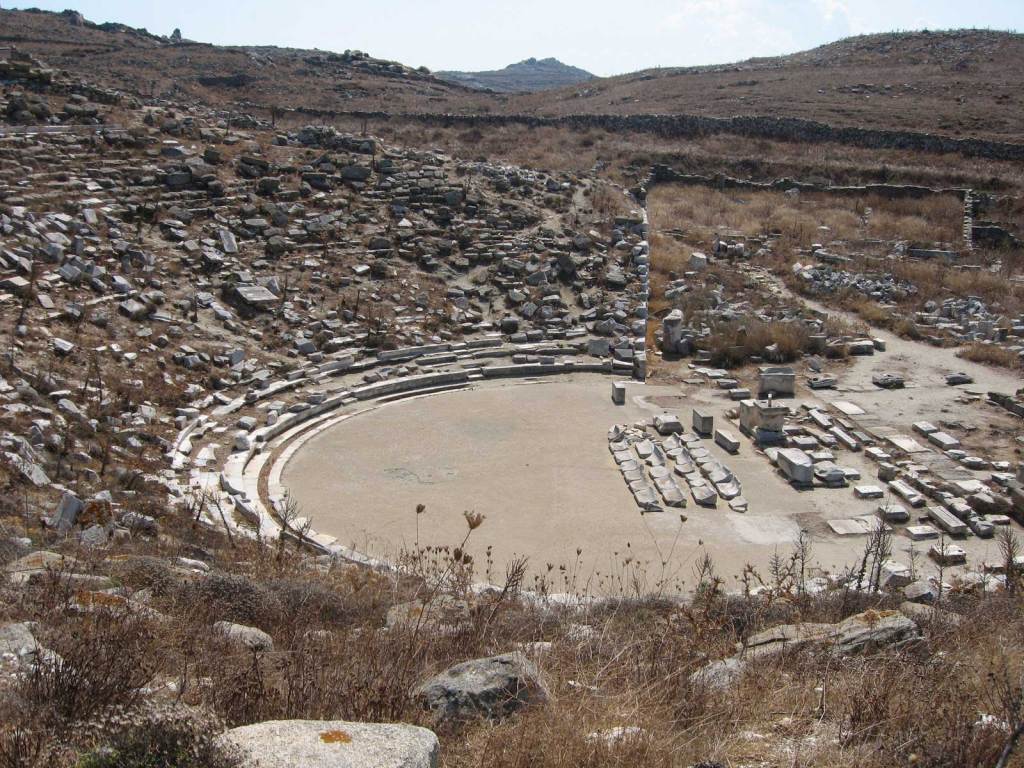The island of Delos is located in the heart of the Cyclades, in the Aegean sea. These islands live up to their name, as they encircle the sacred island where the god Apollo was believed to have been born. It is uninhabited, and in fact overnight stays are prohibited — though you can read below about how famous author Lawrence Durrell managed it.
The island is just 5km (3 miles) long by 1.3km (0.8 miles wide, and is basically just a lump of rock in the Aegean. Travel Tip: Bring your own food and water–and sun screen.
Today the place is only of interest to tourists and archaeologists. But in ancient times it was the intellectual and cultural centre of the Greek world, and also the economic centre.

From Mark Cartwright, Lead Editor at Ancient History Encyclopedia
“This site ranks right up there with Pompeii and the Parthenon as a must see for anyone with a passion for ancient history. The location is breath-taking, yet again, no doubt not an accident, as Greek religious sites were designed to impress not only in terms of architecture but also in terms of geography. It is a sprawling site and best viewed from the hilltop which dominates the island. Ruined temples, the famous row of marble lions, small streets, a theatre, marble seating for tired pilgrims – here there is everything one would hope to see from a site which thrived from the 8th century BCE to the 2nd century CE. There is an onsite museum which houses the original lions and various other pieces of sculpture and pottery. However, it is outside you’ll want to stay.As isolated as it is from the modern world, Delos is one of those rare places where one feels closer to the ancients. This is a magical place and in summer so dry and barren that one can easily believe that only here, far from the other gods, could Leto find sanctuary and give birth to Apollo.”
Myth and history
Mythology tells us that Apollo and his sister Artemis were born on Delos. The first settlers arrived in the 3rd C BC, but it was in the 1st millennium BC that the island became known as the centre of the cult of Apollo.
The Ionians used the island to honour the god by celebrating games in his name. Later, in the 5C BC when the Delian League developed, the Temple of Apollo on the island was selected as the place to store the treasures donated by league members.
A good deal of resentment was directed against Athens in the middle of the 5C BC by other league members. The Athenians relocated the treasure to their own Acropolis, making Delos and the other islands dependent on Athens. This lasted right up to the time of Alexander the Great.
After the power of Athens was broken, the island once again became an important trading centre. This lasted until the island was virtually destroyed by Mithridates in 88 BC. A few years later it was completely destroyed by pirates.
From then it was used occasionally by various groups, such as the Knights Hospitallers in the Middle Ages, and from time to time by pirates.
You can read a more complete history of the ancient Cyclades at the Ancient History Encyclopedia.
Places to see
The Museum
If you’re looking to see the artifacts which have been discovered on the island then you’ll be disappointed, as they are nearly all in the National Archaeological Museum in Athens. But there is a small museum which still contains an interesting collection, including the original lions from the Terrace of the Lions. The ones you can see on the Terrace are replicas.

The Sanctuary
The Sanctuary lies at the heart of the ancient remains. Here you’ll find the Precinct of Apollo and the Precinct of Artemis, together with the Sacred Way. Other areas of interest are the Stoa of the Naxiots and the House of the Naxiots.
The remains of a massive statue of Apollo lie in this area. The Venetians tried to move it but only got it as far as the temple of Artemis. You can clearly see the torso and other parts, with one hand still in the local museum. One of the feet is in the British Museum.

The Lion District
To the north of the Sanctuary is this area named after the Terrace of the Lions which is situated here. Originally there were at least nine of these famous Archaic lions.

The Theatre District
The houses constructed here in the 2C BC were for the many non-Greeks who came to live on the island. This was the period when trade was the driving force. Some of these houses have attractive mosaics on the floors.

Mount Kynthos
If you want a good view of Delos you’ll want to walk to the top of Mount Kynthos. Allow the best part of an hour to complete the return journey.
Once you reach the summit you’ll have a wonderful view. Note the sacred cave which was dedicated to Herakles.
How to get there
The easiest way is to take one of the several day trips –with or without guides– from Mykonos, Paros, Naxos and Tinos. Visit-Cyclades.com can help you with this.
Most of these trips give you about three or four hours on the island. This may sound a long time, but the remains are extensive and with a good guide there is a lot of detail to appreciate. In fact the Latsis Foundation offers a 464 pg. eBook, mostly photos, for those who want to know everything there is to know about Delos. Find it Here
Overnight Stay: Durrell explains how he hired a boatman to fool the Delos guards, and spent a romantic and spiritual night on the sacred island protected by Apollo –and perhaps with the help of Dionysus 🙂
More about Mykonos: Here